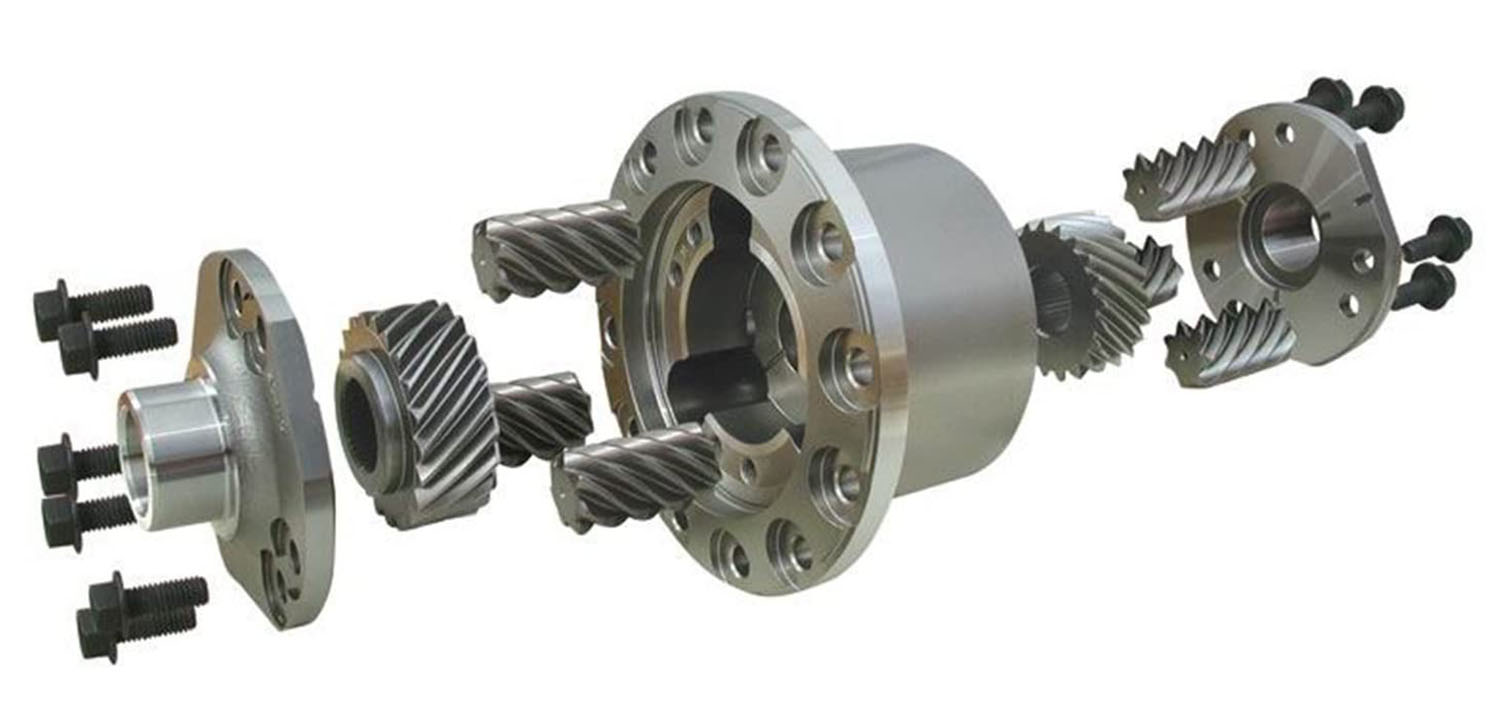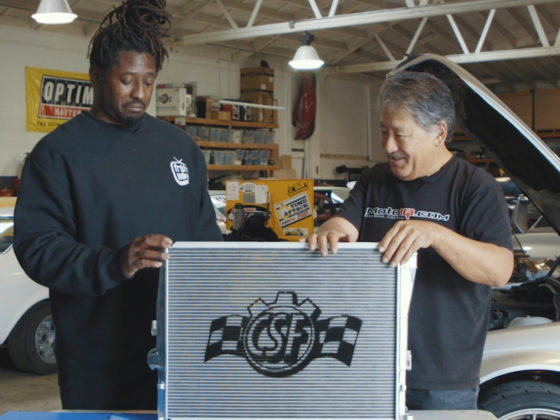 The Eaton Truetrac is a “gear-driven” or “helical-driven” LSD due to the design using outer worm/satellite/planetary/pinion gears that rotate around the main axle/side gears to transfer torque from one wheel to another. The major benefits of this design are zero wear, so nothing needs to be replaced or serviced and the performance will not change over the life of the diff, zero noise or chatter, and it acts like an open diff with no preload mid-corner.
The Eaton Truetrac is a “gear-driven” or “helical-driven” LSD due to the design using outer worm/satellite/planetary/pinion gears that rotate around the main axle/side gears to transfer torque from one wheel to another. The major benefits of this design are zero wear, so nothing needs to be replaced or serviced and the performance will not change over the life of the diff, zero noise or chatter, and it acts like an open diff with no preload mid-corner.
 This exploded view of the stock 28 & 31-spline Ford 8.8” Truetrac shows two set of (3) worm/satellite/planetary/pinion gears that ride around a (2) splined axle-mounted side gears. These outer worm gears sit in a slightly oversized hole that allows for a little play to freely spin against the other worm gear and side gear when cornering. The Truetrac designed for the stronger 8.8” with 33-spline axles utilizes (4) pairs of worm gears, and (5) pairs are used for the stout Ford 9”.
This exploded view of the stock 28 & 31-spline Ford 8.8” Truetrac shows two set of (3) worm/satellite/planetary/pinion gears that ride around a (2) splined axle-mounted side gears. These outer worm gears sit in a slightly oversized hole that allows for a little play to freely spin against the other worm gear and side gear when cornering. The Truetrac designed for the stronger 8.8” with 33-spline axles utilizes (4) pairs of worm gears, and (5) pairs are used for the stout Ford 9”.
 In straight-line driving the entire assembly moves as one unit with no movement between the gears. When cornering, the TrueTrac acts like an open differential, silently and seamlessly allowing differences in speed between the right and left axle-mounted side gears.
In straight-line driving the entire assembly moves as one unit with no movement between the gears. When cornering, the TrueTrac acts like an open differential, silently and seamlessly allowing differences in speed between the right and left axle-mounted side gears.
As the two axles spin at different speeds, the (six) outer worm gears rotate with each other and around the two side-gears with no resistance. When accelerating out of a corner (or braking into a corner), the drivetrain torque/load acts on the worm gear against the side gears, forcing them into the side of the differential housing. This generates friction on the (3) ~0.75” diameter worm gear faces, which resists one tire from spinning. Depending on the overall design and angle of the teeth of these gears determines the differential’s Torque Bias Ratio.
TORQUE BIAS RATIO (GEAR-DRIVEN LSDs)
Torque Bias Ratio (TBR) represents the maximum distribution of torque from one side to another. Multiplying the tractive ability of the (inside) tire with less grip by the TBR will give you the total amount of grip the LSD can send to the outside tire.
For example. If the inside tire can handle 100lb-ft of torque before loosing traction, and the differential has a 3.0:1 TBR like the Truetrac; the differential can send up to 300lb-ft of torque to the outer high-traction tire.
 In the 7 years that I raced an S197 Mustang professionally in the Grand-Am series and multiple other sanctioning bodies and events, driving the FR500C, FR500s, BOSS 302R, BOSS 302S, and multiple club-racing variants; I’ve tested everything from the Eaton Trutrac, Posi, Torsen T-2, T-2R, Detroit Locker, Traction-Lok, and various prototype/one-off Salisbury/clutch-type LSDs.
In the 7 years that I raced an S197 Mustang professionally in the Grand-Am series and multiple other sanctioning bodies and events, driving the FR500C, FR500s, BOSS 302R, BOSS 302S, and multiple club-racing variants; I’ve tested everything from the Eaton Trutrac, Posi, Torsen T-2, T-2R, Detroit Locker, Traction-Lok, and various prototype/one-off Salisbury/clutch-type LSDs.
The concern of a gear-driven (“TOR-SEN”) LSDs lifting the inside wheel and losing forward drive really isn’t a problem in Mustangs with a Truetrac or T-2R LSD and are not poorly setup. If the inside rear tire of the Mustang is unloaded so much to cause this power-down issue with one of these differentials, then there is too much rear roll resistance from an excessively high rear roll center or overly stiff rear springs and/or swaybars. It’s not the right approach to make Mustangs turn simply by stiffening and killing rear grip. Fixing this poor setup philosophy will addresses the issue when using gear-driven LSDs on track and make the car faster and easier to drive.
 Jack Roush Jr. and I finished 3rd overall and won the SSGT2 class in the 2011 Tire Rack One Lap Of America event driving brand new, 540 HP 2012 Roush Stage 3 Mustangs equipped with the Eaton Trutrac LSD. The LSD performed flawlessly over the course of a grueling week and 10+ track events on 285-width tires.
Jack Roush Jr. and I finished 3rd overall and won the SSGT2 class in the 2011 Tire Rack One Lap Of America event driving brand new, 540 HP 2012 Roush Stage 3 Mustangs equipped with the Eaton Trutrac LSD. The LSD performed flawlessly over the course of a grueling week and 10+ track events on 285-width tires.




29 comments
Hey I’ve been there! When I was in college I participated in SAE super mileage, and the competition was held at the Eaton facility. We drove on that oval in something that is best described as a powered soapbox derby car. That oval is not only banked, but it has a pretty serious downhill out of turn 4 before climbing back up the straight.
I am also envious of the condition of the underside of that car. Here in PA that car could just look at a snowflake and be in worse shape.
(BTW, there is a typo on pg6, it’s supposed to read bang for your buck, not bang for your bug.)
Very cool! ..and thanks for the catch.
the early 1960’s Volkswagen Beetle were equipped with gleason differentials in the transaxles …we had a 1963 beetle with a rag top sun roof ..it belonged to my aunt who had the factory service manual break down on the transaxle ..and it was a gleason ..they originally were developed for the 4 wheel drive tow trucks that pull big air planes around on the air strips for traction in ice or snow ..the ones they offer for cars and pickups are only good for about 400 whp ..but it’s good to know they came in the 240-260-280z cars
Wow didn’t know that!
I have 2 engineering degrees and helical gear LSDs remain 80% magic to me. The exploded view helps: basically the diff casing turns the satellite gears, which turn the axle shafts, but if the axles try to turn the satellite gears they struggle to…or something.
But my understanding is that because they rely on the angle between the gears to create TBR, they don’t work in reverse?
Isn’t critical for a track car, but definitely a consideration for a 4×4 application. LSD and thus TruTrac is a pretty attractive option for a front diff…but maybe less so if it doesn’t work in reverse?
Replying to myself with a correction, after a bit of searching: they do work in reverse.
I was thinking about certain kinds of e-lockers that have a ball-on-a-ramp engagement mechanism; the briefly unlock when going from forward to reverse.
The crossed axis ones always were more comprehensible to me – two worm gear sets, themselves geared together, drive the output gears. Worm gears don’t like back torque and the wedging of them resisting it transfers torque. With the parallel gear ones it’s basically the helical twist of the satellite gears pulling them into one side or another of the groove and the friction there wedging stuff to resist rotation.
Unless I, with only one engineering degree, am misunderstanding this too. 😉
I was doing a track day at Summit Point when the 1 Lap cars arrived. They were asking us where the best turn-in and braking spots were, and we were happy to help.
My last track car was a 93 Rx7-TT, with a Torsen in the rear. It was excellent on the track, but a bit too grippy on wet roads. Torsens are all about friction from the gears and the gear end thrust. The outer pairs sit in a cylindrical openings in the carrier with no axle or bearings, just a lot of friction to resist rotation. As the formula for Torsen performance starts with a friction coefficient, I added an extra 1/2 container of the “friction modifier” to make less oversteer. Wonderful LSD like the TruTrac.
I changed the gear oil a couple times during the season, as all the friction caused high temps in the oil, coming out deep black.
This is what I had in my S197 thanks to the last MotoIQ S197 project car… price is kinda nuts compared to how much more expensive LSDs are for almost every other car out there
Seems like I remember the Gleason being the first gear type. They were popular for the 240-260-280z cars.
Also, some of the Audi quattros’ had them factory?
I feel like a broken record, but I was super glad to see you walk away from the tire barrier on Saturday at Sebring. Hoping you catch some better luck here soon!
Thank you for the concern 🙂
Can you wpc a true trac
“wpc” a true trac? what?
yes
Thank you again for the great article and for including links to make it easy for us to order parts to replicate this build. Most of the links provided in the articles are great in that they take us to specific parts that we can add to a cart and purchase directly (ex. Steeda). This is awesome and thank you. The link in this LSD article takes us to the Eaton general web site. This is a great website and very informative; however, does not tell us specifically which LSD you used in your build or you recommend. If contacting Eaton or one of their retailers is recommended, what kind of information would I need to provide. I’m neither an engineer nor a gear head so any direction may provide would be very greatly appreciated.
The make is “Eaton”. The model is “Trutrac”.
Just search for a “Truetrac” for a Ford 8.8″ and you can get them from s number of places. It’s hard to go wrong.
That worked. Much appreciated.
Glad to hear it.
I have something of a bizarre, somewhat-related question concerning…driveshafts in these cars.
During my research phase of selecting an S197, so many S197 owners getting rid of the stock 2-piece setup in favor of a 1-piece…and I’m then seeing a ridiculous amount of vibration issues after the switch to a 1-piece.
The one issue I’ve run into time and time again with Ford RWD products is their perpetual cheaping out on driveshaft tech (hardly any RWD car built by Ford enjoys rear gear upgrades beyond 3.27 gearing).
I’m looking at buying a 2005-2009 S197, I seem to recall that there were issues with the 2010-2014 2-piece units, but what do you recommend…if anything…to run for a DS?
Apologies, I may have answered my own question, but from what research I’ve been able to do, the stock 2-piece driveshaft…while in itself is a brilliant idea, as horribly-engineered long driveshafts are one of Ford’s weak points throughout their RWD history…its execution left a lot to be desired, especially considering Ford apparently doesn’t service the carrier bearing in the middle of the driveshaft, and it wasn’t exactly the highest quality piece to begin with.
The unit I’m seeing the least amount of 1-piece vibration grief with is the DSS (Drive Shaft Shop) piece (available in both aluminum and carbon fiber), as the rear joint is a proper CV unit, although the carbon fiber unit is a weeeeee bit spendy…north of $1300.
I’m probably a little late with this reply. But I just did a Ford performance 1 piece DS in my 2011 GT track pack. I wouldn’t have given it a second thought, but the carrier bearing on the stock 2-piece was clunking during shifts, so I needed to fix it. The ford performance unit is high quality, and a decent amount cheaper than the DSS one, fyi. It’s also roughly the same price as buying a factory replacement 2 piece since ford decided to make the bearing non-serviceable. I don’t notice any vibration issues with the one piece, NVH has remained the same as my factory 2 piece DS. It should be noted that I have other NVH issues from the poly bushing/third link on the rear end, so that may be masking any change in vibration from switching driveshafts. Some like me, report no issues going 1 piece, and others seems to have problems.
Thank you for this excellent write up! If you are changing this out would it make sense to change the ring and pinion ratio? What is best gear ratio for a street/track car? I a 2011 GT with an automatic transmission.
Thank you. It depends on your goals and uses. Although changing the final drive to a 3.55 or 3.73 will be a nice change for an automatic in most cases.
What do you recommend for the best gear ratio for the 2012 Mustang GT 6 spd for street/track with this setup? Thanks
There is TWO versions of the eaton tru-trac. The HD version uses FOUR pinion gears on each side, instead of 3. The casing all the gears are contained in, is thicker and stronger. BUT it’s made for 33 spline axles, not 31 spline axles. ( oem is 31 spline). AFAIK, the only companies making 33 spline axles are …’strange engineering’….and also “Moser engineering’. The HD version is typ used by drag
racers, when their 60′ time is down to 1.4 secs.
Moot point. The normal version is more than ample for street / auto X/ road racing… even with high rear hp..and forced induction.
Point here is…. buy the standard normal version. I installed the normal version of the eaton tru-trac AND the white line Watts link at the same time. The difference was apples and oranges.
Hey Billy, I am going to be ordering a Detroit TrueTrac for my FoxBody Mustang. I still have the 28 spline axles. Will the bias push too much power to one side possibly breaking an axle? Should I upgrade to 31 splines or just get the 28 spline diff and save some money? The engine is only 300 hp. You drove the car at the Cruise for a Cause autocross in the Dells last year.
28 is fine tracking a car with 600whp.
I would like to know if the 8.8 out of a 2014 mustang will bolt up in an 05 gt